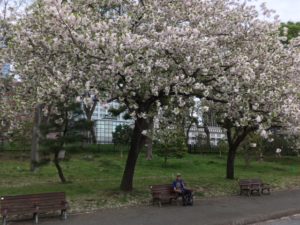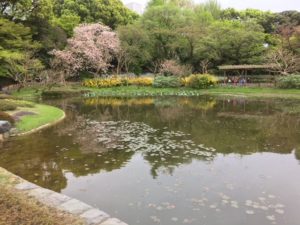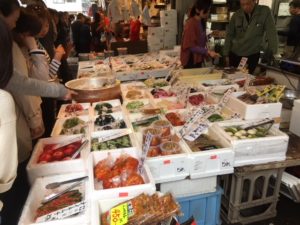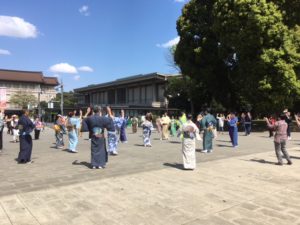
Some cherry trees still held their blossoms.
Fourth in a Series
In most years, we would have landed in Tokyo right at the peak of cherry blossom season.
Alas, my wife, Catharine, and I arrived in the Japanese capital a few days too late in early April this year because the winter there had been unseasonably warm and most of the delicate cherry blossoms had already drifted off the trees in this breezy city.
Nonetheless, some trees remained in full bloom, as did many other types of fruit trees. And as we walked through parks that offer a wonderful respite from Tokyo’s crowded streets, scores of Japanese families were still laying out their traditional picnic blankets and baskets under the cherry trees, blossoms or no. And having a great time of it.
From our little Airbnb-rented apartment in the teeming Shinjuku district, we set out to explore the city — at first on foot, until we discovered the sheer magnitudes involved in this giant metropolis.
We soon discovered the benefits of taking the Metro, Tokyo’s excellent (if sometimes confusing) subway system, which whisks you to the far corners of the city quietly and efficiently. Riders queue up to board at marked locations, stations are announced in both Japanese and English, and little melodies accompany the closing of doors.
It helps to have a Pasmo or Suica card to use as a subway pass, which you can purchase from Japan Experience or other sites before leaving home. And a subway map is a must. Then make sure you’re both on the right line and the right track to get where you’re going. Follow the signs that indicate which direction your chosen stop is, and board your train, which will almost invariably arrive within a few minutes and right on time.
People, People Everywhere
On our first day we just wanted to get a sense of the city, and made our first stop at Shibuya Crossing, reputed to be the world’s busiest intersection. I have no reason to dispute this.
Where everyone comes from I do not know, but it was clear where they were going: across the street, in different directions, and all at once — waves of humanity, both Japanese and foreigners, drawn to this particular crossing, perhaps in large part (at least for the foreigners) because crossing here is considered a mandatory Tokyo experience.

Japanese gardens provide a peaceful respite from the urban hubbub.
Naturally, we also had to cross, facing what seemed to be solid walls of people coming at us from ahead and each side, yet everyone somehow successfully navigated their way without bumping into each other — an agile dance that Tokyo’s subway denizens, hurrying to work in the morning rush hour, haven’t quite mastered.
And what did we do when we reached the other side? Well, turned around and crossed back to the other side, of course.
After Shibuya Crossing, our excursion to the Ginza, Tokyo’s upscale shopping and arts district, seemed downright sedate. We were struck by the extravagant architecture of the Kabukiza Theatre there, where you can buy same-day one-act tickets to watch a Kabuki performance for 1,000 yen (about $10U.S.), but we were too late — you have to get in line by mid-morning. (The performances actually last several hours, but the one-act, one-hour version is usually enough for those who are not Kabuki aficionados.)
The Outer Fish Market
On a subsequent day, we made sure to arrive early at the Tsukiji Outer Market, which remains even as the famous Tsukiji Fish Market, the world’s largest, relocates to another site.
The Outer Market was packed with people even in mid-morning, perusing the seafood and other edibles on display and filling the sushi restaurants that all promised the freshest fish.

The Outer Tsukiji Market, Tokyo
At one stand, we indulged in two plump, freshly opened oysters for 500 yen apiece — and worth every yen.
Then we were seduced into a small sushi restaurant, where we sat at the bar watching the chef deftly prepare our platters of tuna, crab, and other delights — definitely the best and most memorable sushi of my life, and no doubt the most expensive. But after that experience, we felt no need to order sushi again during our stay — anything of lesser quality would have been disappointing, and we’d blown our budget anyway.
Imperial Palace and Gardens
We more or less happened upon the Imperial Palace on a cloudy, breezy afternoon, via a large park where people were snapping pictures of some of the last remaining cherry blossoms.
A long line of visitors was already waiting to be ushered into a tour of one portion of the palace, but we were able to view the moat, high walls, and stone bridge leading to an impressive-looking gate that guards the emperor’s primary residence.
As we walked past the moat, a gust of wind swept Catharine’s hat off her head and into the water, just past a pair of startled swans. When last seen, it was floating away toward the stone bridge and perhaps a pampered life in the imperial realm.
We made our way to the lovely East Gardens, a public park with free entrance where the emperor himself is said to tend to some of the plantings. (The gardens are closed to the public Mondays and Fridays, when, presumably, the emperor exercises his green thumb.)
The gardens displayed a riot of azaleas and other flowers, all amid a peaceful setting of tea houses, koi ponds, and forested paths. At one point we passed an octagon-shaped music hall — reserved for the emperor and his family — and at another a series of trees representing each prefecture of Japan.
Ueno and the Tokyo National Museum
We had no idea when we took the long subway ride to Ueno, site of the world’s largest Japanese art collection at the Tokyo National Museum, that we would end up spending most of the day there.
The subway left us off right at the entrance to what proved to be a cultural and recreational extravaganza, including not just the Tokyo National Museum — which takes you through every era of Japanese art, including the splendid National Treasure Gallery — but the Ueno Zoo, the National Museum of Nature and Science (and several other museums), and a huge park filled with cherry trees, picnickers, and a pond easily big enough to be a lake.

Dancing in traditional dress, at the park in Ueno, Tokyo.
The lake-sized pond, in turn, was filled with families and couples taking spins on rented boats, and the entire area was lined with vendors selling snack items such as grilled squid, fried potato balls (delicious), noodle dishes, and dumplings.
We noshed our way through the vendors till we could nosh no more, and admired the elaborate picnic baskets of food and drink laid out on blankets by families or groups of friends, young and old, who gathered beneath the cherry trees in every conceivable spot.
We couldn’t possibly do justice to all of Ueno in a day — which was much the same as trying to see Tokyo in a bit less than a week, as we did. But while we barely scratched the surface, we did at least get a feel for one of the world’s most vibrant cities.
And there would be much more of Japan to come in the following days.
Next up: Marvelous Kyoto
All Photos by Catharine Norton












Leave a Reply